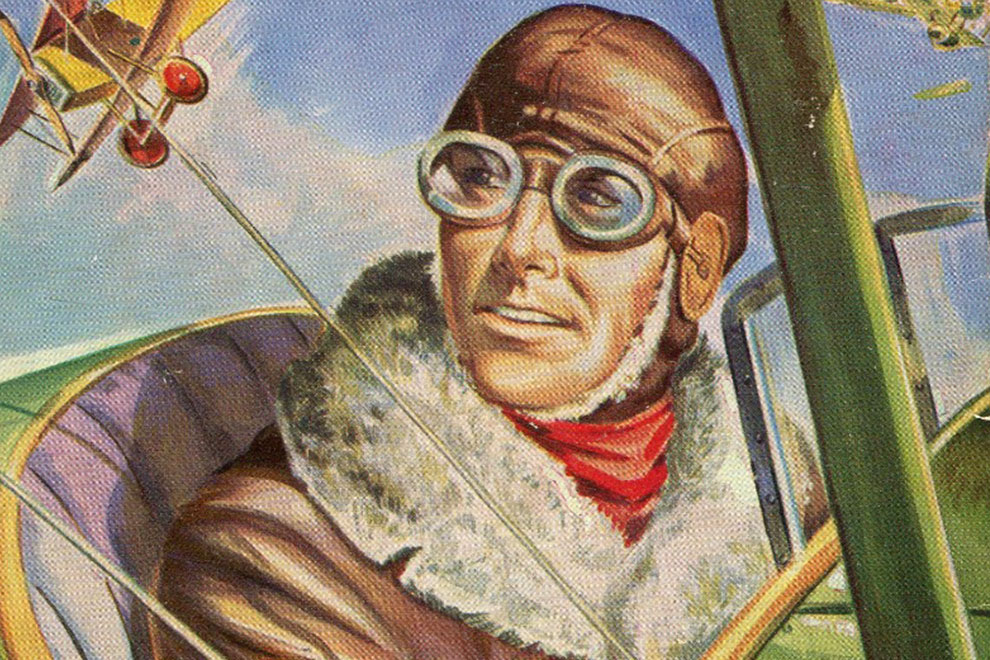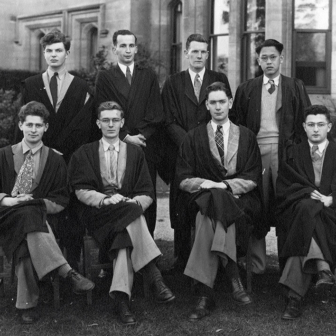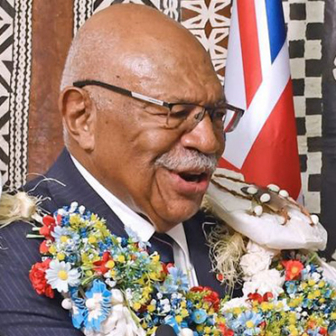The essayist, poet and broadcaster Clive James borrowed from a high school history teacher the term “sludge fiction” to describe the genre of adventure stories for boys of which William Earl Johns’s Biggles series – a suite of almost one hundred novels published between 1932 and 1970 – is an emphatic emblem. Sludge, to James, is the collective term for the preparatory, vocational reading performed in adolescence, often obsessively, which habituates the young reader to the act of reading. It is a sort of pre-critical skill-building, which arranges the reader’s mental furniture to receive the complicated ideas of an adult literacy; or, in the words of James’s teacher, to prepare the mind to “move on to something hard.” Indeed, sludge reading is recalled in adulthood often in terms descriptive of adolescence itself – formative, transitional, faintly embarrassing, fondly remembered but not eagerly relived.
The soft reading of the Biggles corpus – “flying sludge” as James calls it in his fourth volume of Unreliable Memoirs (2006) – is cited as a formative influence by writers as diverse as Seamus Heaney, Ngũgĩ wa Thiong’o and Germaine Greer. Its longevity as a series has sustained several generations of readers. Squadron Leader James Bigglesworth flew throughout the first and second world wars, and enjoyed a postwar career as an intelligence agent for the “Special Air Police,” a supra-national investigative body deployed to various arteries of the Commonwealth in counterespionage operations, mostly in response to perceived communist threats.
At its best, Johns’s work transcends the charge of preliterate juvenile potboiler: his wartime Biggles novels are skilful in portraying the tactical psychology of early twentieth-century aerial combat. The warlike Biggles, in the short story cycles of The Camels Are Coming (1932), Biggles Learns to Fly (1935) and Spitfire Brigade: Biggles at War (1941), or in novels such as Biggles Flies East (1935), is not the broad-chested gentleman–flying ace whose control of the air is asserted as an act of class privilege. Johns’s protagonist in these early stories instead cuts a more complicated figure, as the description of a teenaged Flight-Commander Bigglesworth in the inaugural Biggles tale, “The White Fokker,” first published in April 1932 in Popular Flying magazine, and collected in The Camels Are Coming, makes plain:
His deep set hazel eyes were never still and held a glint of yellow fire that somehow seemed out of place in a pale face upon which the strain of war, and sight of sudden death had already graven little lines. His hands, small and delicate as a girl’s, fidgeted continually with the tunic fastening at his throat. He had killed a man not six hours before. He had killed six men during the past month – or was it a year? – he had forgotten. Time had become curiously telescoped lately.
Here, the pilot is explicitly feminine, diminutive. War inscribes itself on the body; its raiment closes itself around the throat as a chokehold, its practices distort time. Biggles’s inability to keep track of time and death – has he killed six men in one month or twelve? – anticipates by a full decade Albert Camus’s celebrated opening line of tortured psychological detachment in L’Étranger (1942) (“Today, mother died. Or was it yesterday, I’m not sure”). Biggles is virginal, mechaphilic: he talks “not of wine or women as novelists would have us believe, but of a new spring for a Vickers gun.” He is both innocent and experienced. Whatever this is, it surely is not the stuff of a “sludge” pre-critical literacy, as James might have it.
The idea that war causes time to “become telescoped” – for the distant to collapse into the proximate – is suggestive of the prevailing values surrounding the genre, and the arc towards which Johns’s writing ultimately bends: the “knights of the sky.” Johns saw active service throughout his career in the Royal Flying Corps and Royal Air Force, and wrote his subsequent fiction under the nom de guerre honorific “Captain W.E. Johns,” despite retiring from the Royal Air Force with the rank of flying officer, some four ranks below captain. In addition to his early narrative interest in the psychological effects of aerial combat on the combatant, Johns attends closely to war in praxis. His habit of ubiquitous footnoting forms a trove of historical and mechanical detail: the slang terms for various kinds of military aircraft, for example, or the armaments on a Sopwith Camel being fixed to fire through a rotating propeller (resulting occasionally in the pilot shooting off his own blade, as happened to Johns in real life) are vignettes of genuine interest and insight. They speak to the distracted narrative attentions of the expert.
Similarly, the tactics of aerial dogfighting and strategic manoeuvres are explored in careful and often gripping detail within the narrative. Johns frames first world war dogfighting as hand-to-hand combat in the air: it rewards skill, guile and ingenuity in the pilot, and sophistication and technical superiority in the engineer. Wartime prime minister Lloyd George declared that combat pilots “recall the legendary days of chivalry,” while first world war flier Cecil Lewis reminds us that “flying was still something of a miracle. We who practised it... belonged to a world apart.” It is the collapse of the modern into the medieval, where the “world apart” is a space of both historical myth and futuristic innovation – of cutting-edge technology informed by pre-modern codes of comportment. The nervous, self-rending James Bigglesworth of “The White Fokker” and other early wartime stories gives way by strokes to the myth-made chivalric Biggles, as Johns writes his character through and beyond the second world war.
The common term “civil aviation” – that is, flight for leisure – suggests that aviation is intrinsically warlike; but Johns fails singularly to register that whatever value was placed in the “knights of the sky” formulation of aerial combat in the 1910s and 1920s is subverted entirely by the military aviation practices that would be brought to bear in the 1930s and 1940s. The fact that the one-on-one aerial skirmishes between gentleman aces of the first world war are replaced by the sustained civilian bombing and anonymous mass destruction of the second is a development in modern warfare that passes seemingly unobserved in the Biggles corpus.
Biggles in Australia, Johns’s forty-fourth Biggles novel, published in March 1955, is exemplary of Johns’s postwar narrative inability to engage with modernity. The novel takes Biggles and his wingmen Ginger, Algy and Bertie, in their role as counterespionage agents attached to Scotland Yard, to the northwest coast of Australia in pursuit of Biggles’s long-time foil, Hauptmann Erich von Stalhein. Von Stalhein, a Prussian pilot working as an “Iron Curtainmonger” and vocational spy for the Soviets, appears in numerous Biggles novels as the gentleman arch-enemy, pursued by Biggles throughout the Commonwealth. (They each flew for their country during the wars, and each continued in the postwar period in pursuit of espionage.)
Von Stalhein’s allegiances are mercenary, and although described elsewhere as “tall, slim, and good-looking in a rather foppish way,” he is here illustrated as sallow-eyed and unshaven, but of such a stern constitution that “if you hit him in the face with a stone, the stone will go to pieces.” The Biggles of Biggles in Australia, meanwhile, is a pilot who lacks his raison d’être. His “machines” are used not for war but for transport and for sterile inspection. He does not fight von Stalhein; rather, he insipidly gathers evidence, marshals a case.
The distension by Johns of the “knights of the air” mode into this milieu is the foundational anachronism of the postwar Biggles canon. His outmoded view of the pilot feeds inevitably into an anachronistic construction of his environments. His Australia is a space that resists the work of the pilot and the intelligence agent, that favours the quarry over the hunter: “The prospect of finding a man, or even a small army of men, in a place the size of Australia,” Biggles suggests of his search for von Stalhein, “strikes me as having about as much hope of success as a boy looking for a lost peanut on a shingle beach on a dark night.” Indeed, the scale of Australia-as-haystack defies even narrative itself, as Johns intrudes during Biggles’s initial surveillance of the coastal islands to admit: “To narrate in detail the hours that followed would be monotonous reiteration. Suffice it to say that several islands were examined without result.” Australia’s northwest is “perhaps the most forsaken stretch of coast in the world,” where one comes across “as strange an assortment of humanity as could be found on any port on earth.”
The assortment of humanity in Biggles in Australia is forced by Johns to conform to this hierarchy of aviation nobility. Despite having no jurisdiction, Biggles asserts his privilege as a pilot on local Australian law enforcement: murders committed by von Stalhein and his confederates (“all part of a day’s work,” according to Biggles) are described to the “tall, clear-eyed and sun-tanned” Australian investigating officer as “only a side-issue.” To Biggles, there is “more at stake than the shooting of one or two pearlers,” and if Australian authorities investigate domestic crime they “may upset my applecart.” Biggles can see only the global implications of local actions: his ability to act unimpeded is asserted as “more important still for Australia.” And indeed it is: von Stalhein and his assortment of explicitly working-class or crudely mixed-race accomplices – “trouble-making agitators” and “red-hot Communists of the loud-mouthed type” – are in fact engaged in a convoluted plot to destabilise the Australian economy by fomenting what the text calls a “Mau-Mau”–style rebellion in the Indigenous population, while funnelling information about Australia’s uranium supplies and missile systems back to the Soviets.
And it is in this “Mau-Mau plot” – a reference to the ongoing military conflict in Kenya between anti-colonial Indigenous Kenyans and the British army – that we can locate Johns’s worst anachronism. The racism of the book is undisguised and crude: Indigenous Australians are positioned as the bottom rung of von Stalhein’s hierarchy of agitation. They are denominated as “blacks” or “the blacks,” or variously as “natives,” “savages,” “brutes,” and on one occasion, in the singular as “that wop.” They have “animal brains” and “themselves don’t know which way they’ll go” in reacting to new situations. They stare “wide-eyed and open-mouthed” as “their primitive brains strive to keep pace” with developments. The “sight of blood [is] all that [is] necessary to send them crazy,” and “the thin skin of apparent friendliness they pick up from contact with whites” is primed always to break down “when the savage inside ’em bursts through.” They are mute, and are spoken to only in an affected broken English. Von Stalhein’s confederates stoke “a stiffening in attitudes towards whites” among the Indigenous peoples, resulting in repeated and indiscriminate acts of violence and murder.
The plot is secondary, diversionary; it allows cover for the collection and transmission of information about nuclear materials to the communist forces. The nadir of Johns’s “knights of the air” mode here, however, is put into relief in the final setpiece of the novel. After pursuing von Stalhein’s co-conspirators to a remote station in the outback, Biggles’s allies are held in siege by rioting “blacks” – “scores of the devils.” Spears are flung, planes are torched, whites are murdered. As the siege continues, Ginger realises that von Stalhein himself is making his way towards the outstation, unaware that “the blacks are on the warpath” and that the Prussian “may get caught in his own trap.” Ginger decides, therefore, to warn von Stalhein – who has, let us not forget, stolen information pertaining to uranium enrichment and nuclear arms on behalf of the communist powers – that he is heading towards the trap. When questioned on this decision by an Australian member of the allies, Ginger justifies his resolution with the declaration, “There’s something not nice about standing by doing nothing while white people are speared by blacks.”
In this utterance we find in short form the poverty of Johns’s contracted modernity. His outmoded sensibilities towards the nobility of aviation are by necessity here staged in an anachronistic, fictional version of Australia. Even his racism is of an order outdated by the 1950s. In his refusal to register that the “knights of the air” class died with the first world war, Johns remains a writer caught out of time and out of place. The contemporary Australian reader of Biggles in Australia would see not his or her own country reflected in the novel’s pages, but rather a sludge of the fondly remembered. •




